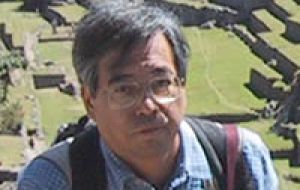MercoPress. South Atlantic News Agency
More evidence that Asians first marched into the Americas
 Anthropologist Ken-ichi Shinoda
Anthropologist Ken-ichi Shinoda A study has revealed genetic links between people who inhabited northern Peru more than 1,000 years ago and the Japanese, according to reports from El Comercio from Lima, one of the country leading newspapers.
Japanese physical anthropologist Ken-ichi Shinoda performed DNA tests on the remains of human bodies found in the East Tomb and West Tomb in the Bosque de Pomas Historical Sanctuary, which are part of the Sican Culture Archaeological Project, funded by Japan's government. The director of the Sican National Museum, Carlos Elera, told El Comercio that Shinoda found that people who lived more than 1,000 years ago in what today is the Lambayeque region, about 800 kilometres north of Lima, had genetic links to the contemporaneous populations of Ecuador, Colombia, Siberia, Taiwan and to the Ainu people of northern Japan. The studies will be continued on descendents of the Mochica culture, from the same region, who are currently working on the Sican Project and with people who live in the vicinity of the Bosque de Pomac Historical Sanctuary. Peruvian archaeologist Luis Chero told El Comercio that "currently, the DNA results have great value because they can be understood to show that there were people who arrived in these zones from Asia and who then converted these zones into the great culture of the New World." The results of the studies will be presented at an exhibit on the Sican culture that will be set up for a year at the Tokyo Museum of Science and Nature. Also to be displayed at that exhibit will be gold, silver and copper jewellery found in the tombs of the ancient Sican rulers and priests.




Top Comments
Disclaimer & comment rulesCommenting for this story is now closed.
If you have a Facebook account, become a fan and comment on our Facebook Page!